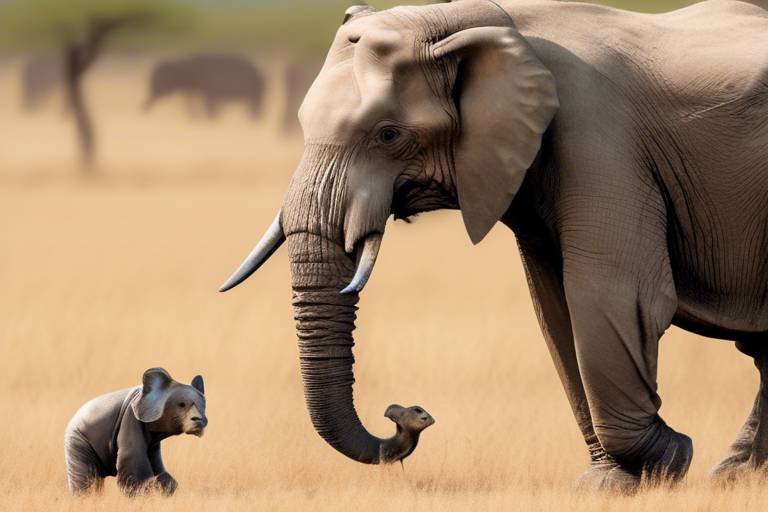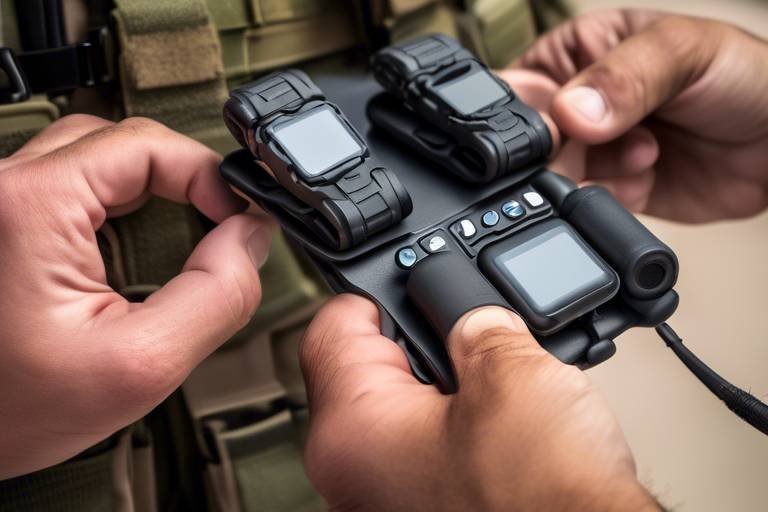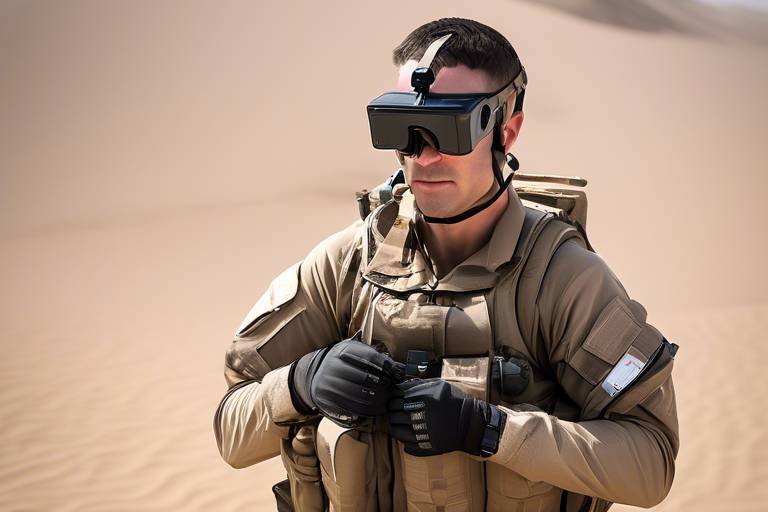How Wearable Sensors Are Used in Wildlife Trafficking Prevention
In a world where the illegal wildlife trade is one of the most lucrative businesses, generating billions of dollars annually, innovative solutions are urgently needed to combat this crisis. Enter wearable sensors, a groundbreaking technology that is revolutionizing wildlife conservation efforts. These devices not only help in tracking endangered species but also play a vital role in preventing wildlife trafficking. Imagine a scenario where conservationists can monitor the movements and health of animals in real-time, making it significantly harder for poachers to operate undetected. This article delves into how wearable sensors are changing the game in the fight against wildlife trafficking, highlighting their effectiveness, technological advancements, and real-world impact on conservation efforts.
Wildlife trafficking poses a significant threat to biodiversity and ecosystems. It's not just about the animals being hunted; it's about the entire web of life that is disrupted. Species such as elephants, rhinos, and tigers are at the forefront of this crisis, often targeted for their valuable parts, like ivory and horns. The criminal networks involved in this illegal trade are sophisticated and well-funded, making it a daunting challenge for conservationists. According to recent statistics, approximately one million species are currently facing extinction, and wildlife trafficking is a major contributor to this alarming trend. Understanding the scope of the problem is the first step in addressing it.
In today's digital age, technology plays a crucial role in modern conservation efforts. Gone are the days when conservationists relied solely on traditional methods. Advancements in technology, particularly wearable sensors, are transforming the way endangered species are monitored and protected. These devices provide invaluable data that can help conservationists make informed decisions. For instance, by using real-time data, they can identify patterns in animal behavior, which can be crucial in predicting potential poaching activities. The integration of technology into conservation strategies not only enhances the effectiveness of these efforts but also enables a proactive approach to wildlife protection.
Wearable sensors come in various forms, each designed for specific tracking and monitoring purposes. Some of the most commonly used sensors in wildlife conservation include:
- GPS Tracking Collars: These collars are essential for monitoring animal movements across vast landscapes.
- Biometric Sensors: These devices provide critical data regarding the health and behavior of wildlife.
Each type of sensor offers unique benefits, enabling conservationists to gather comprehensive data that informs their strategies against wildlife trafficking.
GPS tracking collars are widely used to monitor animal movements. These high-tech collars utilize satellite signals to provide real-time location data, allowing conservationists to track the movements of endangered species with remarkable accuracy. The benefits of using GPS collars include:
- Real-Time Tracking: Conservationists can receive instant updates on the location of animals, enabling rapid response to potential threats.
- Data Collection: Long-term tracking provides valuable insights into migration patterns, habitat use, and social behaviors.
By understanding these patterns, conservationists can implement targeted strategies to protect these vulnerable species from poachers.
Biometric sensors provide valuable data on the health and behavior of wildlife. These devices can monitor physiological parameters such as heart rate, temperature, and stress levels, offering a glimpse into the well-being of animals in their natural habitats. The technology behind these sensors is fascinating, as it allows for non-invasive monitoring, meaning that animals can be studied without disturbing their natural behaviors. This data is crucial for understanding how wildlife responds to environmental changes and human threats, ultimately aiding in the development of effective conservation strategies.
Several successful case studies demonstrate the effectiveness of wearable sensors in wildlife trafficking prevention. For instance, in Africa, GPS collars have been instrumental in tracking elephant herds, leading to significant reductions in poaching incidents. Similarly, biometric sensors have been used in studies of tiger populations, helping researchers understand stress responses associated with habitat loss and human encroachment. These real-world examples highlight the transformative impact of technology on conservation efforts.
Despite the potential of wearable sensors, there are challenges to their implementation. Technical issues, funding constraints, and the need for training among conservationists can hinder the effectiveness of these devices. For instance, in remote areas, the lack of infrastructure can make it difficult to maintain and charge the devices, leading to data gaps. Additionally, the initial costs of deploying such technology can be prohibitive for many conservation organizations.
Technical challenges can hinder the effectiveness of wearable sensors. Issues such as battery life, data accuracy, and the need for robust infrastructure in remote areas are significant hurdles. Conservationists must continually adapt to these challenges to ensure that the data collected is both reliable and actionable.
Funding is crucial for the successful deployment of wearable sensors. Many conservation organizations face financial challenges that limit their ability to invest in advanced technologies. Exploring potential solutions, such as partnerships with tech companies or crowdfunding initiatives, could provide the necessary resources to enhance conservation efforts.
Looking ahead, the future of wearable sensors in wildlife trafficking prevention appears promising. Emerging trends in technology, such as artificial intelligence and machine learning, could further enhance the capabilities of these devices. Furthermore, collaboration among stakeholders—including governments, NGOs, and tech companies—will be essential in developing innovative solutions to protect endangered species. The ongoing evolution of wearable sensors promises to offer even more powerful tools in the fight against wildlife trafficking, ensuring that our planet's biodiversity is preserved for future generations.
Q: How do wearable sensors help prevent wildlife trafficking?
A: Wearable sensors provide real-time data on animal movements and health, allowing conservationists to monitor endangered species and respond quickly to potential poaching threats.
Q: What types of animals can be monitored with wearable sensors?
A: Wearable sensors can be used on a variety of animals, including elephants, rhinos, tigers, and many other endangered species.
Q: Are there any limitations to using wearable sensors in conservation?
A: Yes, challenges include technical issues like battery life, funding constraints, and the need for proper training among conservationists.
Understanding Wildlife Trafficking
Wildlife trafficking is more than just a buzzword; it’s a grave issue that threatens the very fabric of our planet's biodiversity. Imagine a world where majestic elephants, vibrant parrots, and rare tigers are nothing but memories in a history book. Unfortunately, this is the reality we face as illegal wildlife trade continues to flourish. In this section, we’ll dive deep into the scope of wildlife trafficking, exploring the species that are most affected and the criminal networks that perpetuate this heinous act.
At its core, wildlife trafficking refers to the illegal trade of animals and plants. This trade is not just limited to the sale of exotic pets; it encompasses a wide range of activities, including poaching, smuggling, and the sale of body parts. The World Wildlife Fund estimates that the illegal wildlife trade is worth up to $23 billion annually, making it one of the most profitable illegal activities globally, second only to drug trafficking.
Many species are caught in the crosshairs of wildlife trafficking, but some are particularly vulnerable. For instance, the African elephant is hunted for its ivory tusks, while rhinos are poached for their horns, which are falsely believed to have medicinal properties. Birds, reptiles, and even marine life are not spared either. The demand for exotic pets has led to the decline of many species, pushing them closer to extinction. Here are a few species that are significantly affected:
- Elephants: Hunted for ivory.
- Rhinos: Poached for their horns.
- Tigers: Targeted for their skins and body parts.
- Parrots: Captured for the exotic pet trade.
The criminal networks behind wildlife trafficking are highly organized and operate across borders. These syndicates often use sophisticated methods to smuggle wildlife products, making it incredibly challenging for law enforcement to combat them. They exploit weaknesses in regulations and take advantage of the lack of resources in many countries. This not only endangers wildlife but also undermines local communities that rely on these species for their livelihoods. The impact of wildlife trafficking ripples through ecosystems, leading to imbalances that can have devastating effects on the environment.
In conclusion, understanding wildlife trafficking is crucial for anyone interested in conservation. It’s not just a matter of protecting endangered species; it’s about preserving the delicate balance of our ecosystems. As we move forward in this article, we’ll explore how technology, particularly wearable sensors, is revolutionizing the fight against this pressing issue. Stay tuned as we uncover the innovative solutions that are paving the way for a brighter future for wildlife.
The Role of Technology in Conservation
In today's world, technology is not just a luxury; it has become an essential tool in the fight for conservation. The challenges our planet faces, especially regarding wildlife trafficking, are monumental. But guess what? Technology is stepping up to the plate like a superhero in a blockbuster movie! From advanced tracking systems to data analytics, tech is revolutionizing how we monitor and protect endangered species. Imagine being able to track a majestic elephant's movements in real-time or monitor the health of a rare bird without disturbing its natural habitat. This is the power of technology in conservation.
Wearable sensors are at the forefront of this technological revolution. These devices are designed to collect critical data that can inform conservation strategies. They help scientists and conservationists understand animal behavior, migration patterns, and even physiological responses to environmental changes. With the data gathered, conservationists can make informed decisions that enhance their efforts to protect wildlife. This is akin to having a backstage pass to the lives of these animals, allowing us to understand their needs better and respond to threats more effectively.
Moreover, the integration of technology goes beyond just tracking animals. It encompasses a wide range of innovative solutions, including:
- Camera Traps: These devices capture images of wildlife, providing insights into species populations and behaviors.
- Drones: Drones are used for aerial surveys, enabling conservationists to monitor vast areas of land without disturbing wildlife.
- Mobile Apps: With the rise of smartphones, mobile applications are being developed to report illegal activities and engage local communities in conservation efforts.
The collaboration between technology experts and conservationists is crucial. By working together, they can develop tailored solutions that address specific challenges faced in different ecosystems. For instance, in densely forested areas, drones can provide a bird's-eye view of the landscape, identifying poaching hotspots that might be invisible from the ground. This synergy is not just about using technology; it’s about creating a comprehensive strategy that leverages the strengths of both fields.
In conclusion, the role of technology in conservation is not just a passing trend; it is a fundamental shift in how we approach wildlife protection. With wearable sensors and other technological advancements, we are better equipped than ever to combat wildlife trafficking and ensure the survival of endangered species. As we continue to innovate and adapt, the potential for positive change grows exponentially. The future of conservation is bright, and technology is leading the way.
Types of Wearable Sensors
When it comes to wildlife conservation, wearable sensors are like the Swiss Army knives of technology. They come in various forms, each tailored to meet specific needs in the field of monitoring and tracking wildlife. Understanding the different types of these sensors can help us appreciate how they contribute to the fight against wildlife trafficking.
One of the most commonly used types of wearable sensors is the GPS tracking collar. These collars are designed to provide real-time location data, allowing conservationists to monitor animal movements over vast areas. Imagine being able to track the journey of an endangered species across mountains, forests, and plains, all from the comfort of a computer screen. This technology not only aids in understanding migration patterns but also helps in identifying critical habitats that need protection.
In addition to GPS collars, we have biometric sensors. These devices are like health monitors for wildlife, collecting data on various physiological parameters such as heart rate, body temperature, and stress levels. By analyzing this information, researchers can gain insights into the health and well-being of different species. For instance, if a particular animal shows elevated stress levels, it could indicate disturbances in its habitat or threats from poaching activities. Such data is invaluable for making informed conservation decisions.
Another exciting innovation is the use of accelerometers, which track the movement and activity levels of wildlife. These sensors can provide detailed information about an animal's behavior, such as how much time it spends feeding, resting, or engaging in social interactions. This type of data is crucial for understanding the ecological roles of various species and how they interact with their environment.
Moreover, environmental sensors are also gaining traction in wildlife conservation. These sensors monitor environmental conditions like temperature, humidity, and air quality, providing context to the data collected from animal sensors. For example, if an animal is showing signs of distress, environmental data can help determine if there are external factors at play, such as habitat degradation or climate change.
In summary, the variety of wearable sensors available today is expanding the toolkit for conservationists. Each type serves a unique purpose, contributing to a comprehensive understanding of wildlife behavior and health. By integrating data from these sensors, researchers can create a more holistic view of the challenges faced by endangered species and devise strategies to combat wildlife trafficking effectively.
GPS Tracking Collars
GPS tracking collars have revolutionized the way conservationists monitor wildlife, providing real-time data that is crucial for understanding animal movements and behaviors. These collars are equipped with advanced GPS technology, allowing researchers to track the location of animals with incredible precision. Imagine being able to follow the journey of a majestic elephant or a rare snow leopard as they traverse their natural habitat—this is precisely what GPS collars enable us to do.
The way these collars work is quite fascinating. They use satellite signals to determine the animal's location and can transmit this data to conservationists via cellular networks or satellite communication. This real-time tracking capability allows for immediate responses to any potential threats, such as poaching or habitat encroachment. For instance, if a collar indicates that an animal has suddenly stopped moving in a known poaching area, conservation teams can be alerted to investigate and intervene if necessary.
One of the major benefits of GPS tracking collars is their ability to gather extensive data over time. Not only do they provide location information, but they can also collect data on movement patterns, migration routes, and even social interactions within species. This data is invaluable for conservation efforts, as it helps scientists understand the ecological needs of various species and develop strategies to protect them. For example, by analyzing movement data, researchers can identify critical habitats that need protection or corridors that facilitate safe animal migration.
However, while GPS tracking collars are incredibly effective, they are not without their challenges. The collars must be lightweight and comfortable for the animal to wear, which can sometimes limit the technology that can be used. Additionally, the battery life of these devices is a crucial factor; conservationists need to ensure that the collars can operate for extended periods without frequent replacements. Despite these challenges, the benefits far outweigh the drawbacks, making GPS tracking collars a vital tool in the fight against wildlife trafficking.
In conclusion, GPS tracking collars are not just technological marvels; they are essential instruments in the preservation of biodiversity. By providing insights into animal behavior and movements, they empower conservationists to make informed decisions that can save endangered species from the brink of extinction. As technology continues to advance, we can only anticipate even more innovative applications of GPS collars in wildlife conservation.
Biometric Sensors
Biometric sensors are revolutionizing the way we understand and protect wildlife. These advanced devices are designed to collect a plethora of data regarding the health and behavior of animals in their natural habitats. Imagine having a tiny health monitor strapped to an endangered species that not only tracks their movements but also provides real-time insights into their physiological state. This is exactly what biometric sensors do, and their impact on conservation efforts is profound.
These sensors can measure various vital signs, such as heart rate, body temperature, and activity levels. By analyzing this data, conservationists can gain a clearer picture of an animal's well-being and stress levels, which are crucial indicators of their overall health. For example, a sudden spike in heart rate could indicate that an animal is under threat, possibly from poachers or habitat destruction. With this information, conservation teams can act swiftly to protect these vulnerable creatures.
Moreover, biometric sensors can also help in understanding the breeding patterns and social behaviors of different species. By monitoring how animals interact with one another, researchers can gather insights into their social structures and reproductive habits. This knowledge is invaluable for creating effective conservation strategies aimed at preserving biodiversity. In fact, studies have shown that animals that are monitored with biometric sensors often exhibit improved health outcomes, thanks to timely interventions based on the data collected.
One of the most exciting aspects of biometric sensors is their ability to transmit data wirelessly. This means that conservationists can monitor animals from a distance, reducing the need for intrusive tracking methods that could stress the animals. Some of these sensors are even equipped with GPS capabilities, allowing for comprehensive tracking combined with health monitoring. As technology continues to evolve, we can expect biometric sensors to become even more sophisticated, offering deeper insights into wildlife health and behavior.
However, it's essential to acknowledge that while biometric sensors are powerful tools, they are not without challenges. The accuracy of the data collected can be affected by various factors, including environmental conditions and the physical condition of the animal wearing the sensor. Therefore, ongoing research and development are crucial to enhance the reliability of these devices. Despite these challenges, the potential of biometric sensors in wildlife conservation is immense, paving the way for more informed and effective conservation efforts.
- What are biometric sensors? Biometric sensors are devices that monitor and collect data on the health and behavior of wildlife, including vital signs like heart rate and body temperature.
- How do biometric sensors aid in wildlife conservation? They provide real-time insights into animal health, enabling timely interventions and a better understanding of species behavior and social structures.
- Are there any challenges associated with using biometric sensors? Yes, challenges include data accuracy, environmental factors affecting sensor performance, and the need for ongoing research to improve technology.
Case Studies of Successful Implementations
When it comes to tackling the pressing issue of wildlife trafficking, the integration of wearable sensors has proven to be a game-changer. Various case studies illustrate how these technologies have been effectively employed to monitor endangered species and disrupt illegal activities. One notable example is the use of GPS tracking collars on elephants in Africa. Conservationists fitted these collars on a group of elephants in a protected reserve. The real-time tracking data allowed them to monitor the elephants' movements closely, identifying patterns that indicated potential poaching threats. This proactive approach not only helped protect these magnificent creatures but also led to the arrest of several poachers operating in the area.
Another compelling case study comes from the efforts to protect the critically endangered Sumatran tiger. Researchers deployed biometric sensors to monitor the health and stress levels of these elusive cats. The data collected provided invaluable insights into their behavior and well-being, enabling conservationists to respond swiftly to any signs of distress or health issues. In one instance, the data revealed that a particular tiger was experiencing high stress due to encroachment from nearby human settlements. Armed with this information, conservation teams were able to implement measures to mitigate human-wildlife conflict, significantly improving the tiger's chances of survival.
Moreover, in Southeast Asia, a project aimed at protecting endangered pangolins utilized a combination of GPS collars and environmental sensors. The collars tracked the pangolins' movements while the environmental sensors monitored habitat conditions. This dual approach provided a comprehensive view of how habitat loss and environmental changes impacted the pangolins' behavior and survival. The findings not only aided in the immediate protection of these animals but also contributed to broader conservation strategies aimed at preserving their natural habitats.
These case studies highlight the transformative impact of wearable sensors in conservation efforts. By providing real-time data and insights into animal behavior, these technologies empower conservationists to take informed actions. The success of these implementations serves as a beacon of hope, demonstrating that with the right tools and strategies, we can combat wildlife trafficking and protect our planet's biodiversity.
- What are wearable sensors? Wearable sensors are devices attached to animals that collect data on their movements, health, and environmental conditions.
- How do GPS collars work? GPS collars use satellite technology to track the location of animals in real-time, helping conservationists monitor their movements and identify threats.
- What are biometric sensors used for? Biometric sensors measure physiological data, such as heart rate and stress levels, providing insights into an animal's health and behavior.
- Can wearable sensors prevent wildlife trafficking? Yes, by monitoring endangered species and providing real-time data, wearable sensors can help conservationists take proactive measures against poaching and trafficking.
- What challenges do conservationists face when using wearable sensors? Challenges include technical issues, funding constraints, and the need for training among conservationists to effectively use the technology.
Challenges and Limitations
Despite the remarkable potential of wearable sensors in wildlife trafficking prevention, several hinder their widespread implementation and effectiveness. One of the most pressing issues is the technical challenges associated with these devices. For instance, many wearable sensors rely on battery power, and in remote areas where wildlife often resides, battery life can be a significant concern. Conservationists may find themselves in situations where the sensors run out of power, leading to gaps in data collection and monitoring. Furthermore, the accuracy of data collected by these sensors is paramount. If the sensors malfunction or provide inaccurate readings, it can mislead conservation efforts and hinder effective decision-making.
Another major hurdle is the funding and resource constraints faced by many conservation organizations. Implementing a comprehensive wildlife monitoring system using wearable sensors requires substantial financial investment. This includes costs for the sensors themselves, maintenance, data analysis, and the necessary training for personnel. Unfortunately, many conservation initiatives operate on tight budgets, which can limit their ability to adopt and maintain advanced technologies. The following table highlights some of the common funding challenges:
| Funding Challenge | Description |
|---|---|
| Limited Grants | Many organizations struggle to secure sufficient grant funding to cover the costs of technology implementation. |
| High Maintenance Costs | Wearable sensors require ongoing maintenance, which can strain limited budgets. |
| Lack of Corporate Sponsorship | Without partnerships with corporations, many conservation efforts lack the financial backing needed for technology. |
In addition to technical and financial challenges, there is also a significant need for training and capacity building among conservationists. Many organizations may not have personnel who are adequately trained to use these advanced technologies effectively. This gap can lead to underutilization of the sensors and a failure to collect valuable data that could aid in wildlife protection. Training programs are essential to ensure that conservationists can leverage the full potential of wearable sensors.
Ultimately, while wearable sensors hold great promise in the fight against wildlife trafficking, addressing these is crucial for maximizing their effectiveness. Collaboration among stakeholders, including governments, NGOs, and private sector partners, is essential to overcome these barriers. By pooling resources and expertise, we can pave the way for a more robust and effective approach to wildlife conservation.
- What are wearable sensors? Wearable sensors are devices attached to wildlife that monitor various data points, such as location, health metrics, and behavior.
- How do wearable sensors help in wildlife trafficking prevention? They provide real-time data that helps conservationists track endangered species and detect illegal activities.
- What are the main challenges in using wearable sensors? Key challenges include technical issues, funding constraints, and the need for proper training among conservationists.
- Are there successful examples of wearable sensors in conservation? Yes, there are numerous case studies demonstrating their effectiveness in tracking and protecting endangered species.
Technical Challenges
While the integration of wearable sensors in wildlife conservation is undoubtedly a game-changer, it doesn't come without its share of . One of the primary hurdles conservationists face is the battery life of these devices. Imagine trying to monitor a majestic elephant roaming vast savannahs, only to find that the sensor's battery dies in just a few days. This limitation can severely hinder long-term tracking efforts, making it crucial for developers to innovate and create more efficient power solutions.
Another significant issue revolves around data accuracy. The effectiveness of wearable sensors heavily relies on the reliability of the data they collect. Factors such as environmental conditions, animal behavior, and even interference from other electronic devices can lead to inaccuracies. For instance, if a GPS collar misreads an animal's location, it could mislead conservationists, resulting in wasted resources and potentially jeopardizing the safety of the species being monitored.
Moreover, the deployment of these sensors often takes place in remote areas, which presents its own set of challenges. The lack of robust infrastructure in these regions can complicate data transmission and make it difficult to maintain the equipment. Picture a conservationist in the heart of a dense jungle, struggling with poor connectivity that prevents them from receiving real-time updates on animal movements. This scenario highlights the importance of establishing reliable communication networks to support the technology.
To further illustrate these challenges, consider the following table that summarizes key technical issues faced with wearable sensors:
| Technical Challenge | Description |
|---|---|
| Battery Life | Short battery duration limits long-term monitoring capabilities. |
| Data Accuracy | Environmental factors can lead to incorrect readings. |
| Infrastructure | Poor connectivity in remote areas complicates data transmission. |
Addressing these challenges requires not just technological advancements but also collaboration among various stakeholders. Conservationists, technologists, and funding organizations must unite to overcome these barriers. By pooling resources and sharing knowledge, they can develop better solutions that enhance the effectiveness of wearable sensors in wildlife trafficking prevention.
Funding and Resource Constraints
When it comes to implementing innovative technologies like wearable sensors in wildlife conservation, one of the most pressing issues is the challenge of funding. Conservation organizations often operate on tight budgets, and the costs associated with acquiring, deploying, and maintaining these advanced technologies can be daunting. For instance, a single GPS collar can cost several hundred dollars, and when you consider the number of animals that need monitoring, the expenses can quickly escalate.
Moreover, the financial constraints are not just about the initial costs. Ongoing expenses such as data management, regular maintenance of the sensors, and the training of personnel to operate these technologies also add to the financial burden. Many organizations find themselves in a constant struggle to secure the necessary resources, which can lead to delays in conservation efforts or, worse, the abandonment of critical projects altogether.
In addition to the direct costs, there is also the matter of resource allocation. Conservationists need to prioritize their spending, often leading to tough decisions about which projects to fund. For example, if an organization is focused on monitoring a specific endangered species, they may have to forego other essential conservation projects that could also benefit from technological advancements.
To address these funding challenges, many organizations are seeking alternative funding sources. These can include:
- Grants from governmental and non-governmental organizations
- Partnerships with private companies that have an interest in conservation
- Crowdfunding initiatives that engage the public in supporting conservation efforts
Additionally, awareness campaigns can play a crucial role in securing funding. By highlighting the importance of wildlife conservation and the role of technology in these efforts, organizations can inspire individuals and corporations to invest in these initiatives. For instance, social media platforms can be powerful tools for raising awareness and attracting potential donors.
Ultimately, while the challenges of funding and resource constraints are significant, they are not insurmountable. By fostering collaboration among stakeholders, leveraging technology for fundraising, and advocating for the importance of wildlife conservation, organizations can overcome these hurdles and continue their vital work in protecting endangered species from the threats of wildlife trafficking.
Q1: What are wearable sensors?
Wearable sensors are advanced devices that can be attached to wildlife to monitor their movements, health, and behavior in real-time. They provide critical data that helps conservationists protect endangered species.
Q2: How do funding constraints affect wildlife conservation?
Funding constraints can limit the ability of conservation organizations to implement and maintain technologies like wearable sensors, hindering their efforts to monitor and protect endangered species effectively.
Q3: What are some alternative funding sources for conservation projects?
Alternative funding sources can include grants from governmental and non-governmental organizations, partnerships with private companies, and crowdfunding initiatives that engage the public in supporting conservation efforts.
Q4: Why is technology important in wildlife conservation?
Technology enhances the ability of conservationists to monitor wildlife populations, track movements, and gather data on health and behavior, which are crucial for effective conservation strategies.
The Future of Wearable Sensors in Conservation
The future of wearable sensors in wildlife conservation is not just bright; it’s practically glowing with potential! As technology continues to evolve at a breakneck pace, these devices are becoming increasingly sophisticated, offering unprecedented opportunities for protecting endangered species and combating wildlife trafficking. Imagine a world where conservationists can monitor animal health and movements in real-time from the comfort of their homes. Sounds like science fiction, right? Well, it’s becoming a reality!
One of the most exciting trends on the horizon is the integration of artificial intelligence (AI) with wearable sensors. By leveraging AI, conservationists can analyze vast amounts of data collected from these sensors to identify patterns and predict behaviors. For instance, AI can help determine when animals are likely to migrate or when they are under stress, allowing for timely interventions. This could be a game-changer in preventing poaching and protecting habitats.
Moreover, advancements in battery technology are set to enhance the functionality of these devices. Imagine sensors that can last for months or even years without needing a recharge! This would significantly reduce the logistical challenges associated with deploying and maintaining these devices in remote areas. Additionally, the development of solar-powered sensors could further extend their operational lifespan, making them more sustainable and cost-effective.
Another fascinating aspect of the future of wearable sensors is the potential for collaboration among stakeholders. Conservation organizations, tech companies, and governments can come together to create comprehensive solutions that address wildlife trafficking effectively. By sharing data and resources, these entities can enhance their strategies and develop a unified front against illegal wildlife trade. After all, when it comes to conservation, teamwork makes the dream work!
Furthermore, the accessibility of technology is likely to improve. As wearable sensors become more affordable, smaller conservation teams in developing countries will have the opportunity to utilize these tools. This democratization of technology means that conservation efforts can become more widespread and impactful, reaching areas that were previously overlooked.
To sum it up, the future of wearable sensors in conservation is not just about the technology itself but also about how we can harness it to create a better world for wildlife. With the right innovations and collaborations, we can equip conservationists with the tools they need to make a real difference. It’s a thrilling time for conservation, and the possibilities are as vast as the wilderness we aim to protect!
- What are wearable sensors? Wearable sensors are devices that can be attached to animals to monitor their movements, health, and behavior.
- How do wearable sensors help in wildlife conservation? They provide real-time data that helps conservationists track endangered species, understand their needs, and prevent illegal activities like poaching.
- What advancements are expected in wearable sensors? Future advancements may include AI integration, improved battery life, and solar-powered options, making them more efficient and sustainable.
- Can wearable sensors be used in remote areas? Yes, with advancements in technology, wearable sensors are becoming more robust and capable of functioning in remote locations.
Frequently Asked Questions
- What is wildlife trafficking?
Wildlife trafficking refers to the illegal trade of animals and plants, often involving endangered species. This illicit activity threatens biodiversity and disrupts ecosystems, as it often targets vulnerable species for profit.
- How do wearable sensors help in wildlife conservation?
Wearable sensors assist in wildlife conservation by providing real-time data on animal movements, health, and behavior. This information enables conservationists to monitor endangered species more effectively and respond swiftly to threats, including poaching.
- What types of wearable sensors are commonly used?
Common types of wearable sensors include GPS tracking collars and biometric sensors. GPS collars track animal movements, while biometric sensors gather data on health indicators, such as heart rate and stress levels.
- Can you give an example of successful implementation of wearable sensors?
Sure! One notable example is the use of GPS collars on elephants in Africa, which has helped track their migration patterns and reduce human-wildlife conflict. This data has been crucial in developing strategies to protect these majestic creatures from poaching.
- What are some challenges faced in using wearable sensors?
Challenges include technical issues like battery life and data accuracy, as well as funding constraints that limit the deployment of these technologies. Additionally, training conservationists to use this technology effectively is essential for success.
- What is the future of wearable sensors in wildlife conservation?
The future looks bright! Emerging trends suggest advancements in sensor technology and increased collaboration among stakeholders, which will enhance the effectiveness of conservation efforts and help protect endangered species more efficiently.



















